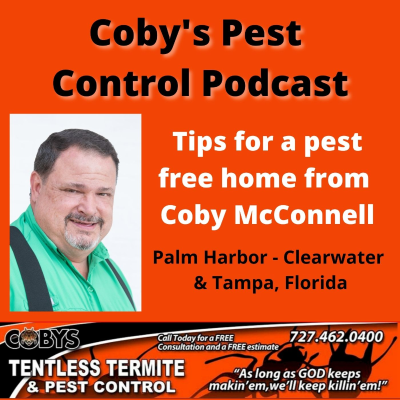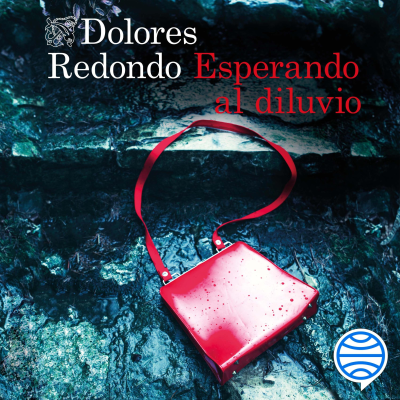
Coby's Pest Control & Tentless Termite Podcast
Podcast de Coby's Pest Control & Tentless Termite Podcast
Empieza 7 días de prueba
$99 / mes después de la prueba.Cancela cuando quieras.

Más de 1 millón de oyentes
Podimo te va a encantar, y no estás solo/a
Rated 4.7 in the App Store
Acerca de Coby's Pest Control & Tentless Termite Podcast
Tips for a pest free home in Palm Harbor, Clearwater and Tampa, FL with Coby McConnell
Todos los episodios
10 episodiosAlright, folks, Coby McConnell here again, your friendly neighborhood pest pro from Coby’s Tentless Termite and Pest Control! We’ve talked about a whole rogues’ gallery of lawn destroyers – chinch bugs, sod webworms, and even those root-munching grubs. But today, we’re shining a spotlight on another sneaky subterranean menace that can turn your beautiful Clearwater and Tampa lawn into a lumpy, damaged mess: the mole cricket! Now, these aren’t your typical crickets that just jump around and chirp. Oh no. Mole crickets are built for destruction, and they absolutely thrive in our warm, sandy Florida soils. They’re like little underground bulldozers with a nasty appetite! SO, WHY ARE MOLE CRICKETS SUCH A MENACE IN OUR CLEARWATER AND TAMPA LAWNS? You guessed it – our perfect Florida climate! The warm temperatures and often moist soil conditions create an ideal environment for mole crickets to dig, feed, and reproduce. And they’re particularly fond of St. Augustine and Bahia grasses, which are common sights across our beautiful region. Here’s the scoop on why these tunneling terrors are such a problem: * Underground Tunnelers: These guys are masters of subterranean construction. They have powerful, shovel-like forelegs designed for digging, and they create extensive networks of tunnels just beneath the surface of your lawn. These tunnels disrupt the grass roots, causing the turf to dry out and die. You’ll see raised “ridges” or “mounds” of soil, especially after rain or irrigation. * Root and Shoot Feeders: While their tunneling causes significant damage, the mole crickets themselves (both nymphs and adults) also feed on the roots, rhizomes, and even tender shoots of your grass. It’s a double whammy of destruction! * Rapid Reproduction: Our warm climate allows mole crickets to complete their life cycle relatively quickly, meaning multiple generations can be present throughout the year, with peak activity often in late spring through early fall. A small problem can quickly escalate! * Attracting Predators: Just like grubs, mole crickets are a tasty meal for various animals. If you notice an increase in armadillos, raccoons, skunks, or even birds digging up your lawn, they might be after these subterranean snacks. And while those critters are helping you out, they’re making an even bigger mess of your lawn. * Nocturnal Nuisances: Mole crickets are most active at night, especially after rain or watering. This makes them hard to spot in the act of destruction, so you often only see the damage they leave behind. * The “Chirping” Clue: While many species cause damage, some male mole crickets will “sing” (chirp) during mating season, often at dusk or night. If you hear a distinctive, continuous chirping coming from your lawn, especially near lights, that’s a strong indicator you’ve got mole crickets. HOW DO YOU KNOW IF YOU’VE GOT THESE TUNNELING TERRORS? Mole cricket damage can sometimes be mistaken for drought stress or even grub activity. Here’s what to look for: * Raised Tunnels/Ridges: The most distinctive sign is the presence of meandering, raised tunnels or ridges of displaced soil in your lawn, resembling miniature mole runs. * Patchy, Dying Grass: As they tunnel and feed, areas of your lawn will start to yellow, wilt, and eventually die. These patches often follow the path of their tunnels. * Spongy Turf: In areas with heavy tunneling, the turf may feel loose or spongy underfoot because the roots have been severed. * Loose Soil: Digging in affected areas may reveal loose, crumbly soil where they’ve been tunneling. * The Soap Flush Test: Just like with sod webworms and grubs, you can do a “soap flush.” Mix 1-2 tablespoons of liquid dish soap in 2 gallons of water and pour it evenly over a 2×2 foot area of damaged lawn. Wait 5-10 minutes. If mole crickets are present, they’ll often come scurrying to the surface! SO, WHAT’S THE GAME PLAN FOR KICKING THESE MOLE CRICKETS OUT? Dealing with mole crickets requires a strategic approach, especially since they’re often hidden. Good lawn care helps, but usually, you need to bring in the pros. 1. Smart Lawn Care (Your First Defense): * Proper Mowing: Maintain a healthy mowing height for your St. Augustine or Bahia grass (3.5-4 inches). Taller grass is generally more resilient. * Water Wisely: Water deeply and infrequently to encourage strong, deep root growth, which can better withstand some damage. Avoid overwatering, as overly wet conditions can sometimes attract them. * Reduce Thatch: A thick thatch layer can provide excellent cover for mole crickets. Regular dethatching or aeration can help reduce their habitat. 2. Professional Mole Cricket Control: The Coby’s Tentless Termite and Pest Control Advantage! Trying to tackle mole crickets on your own can be a frustrating and often ineffective battle. These pests can be persistent, and applying the wrong product at the wrong time just wastes your money and lets them continue their destruction. That’s why your trusted pros at Coby’s are your best bet! * Expert Identification: We’ll confirm that mole crickets are indeed the culprits, ensuring we apply the most effective treatment. Different species can have different peak activity times. * Targeted & Timely Treatments: We use professional-grade insecticides specifically designed to control mole crickets. The timing of the application is crucial; we know when nymphs (the younger, more vulnerable stages) are most active and susceptible, typically in late spring to early summer, and again in late summer/early fall. * Residual Control: Our treatments are designed to provide residual control, continuing to work even after the initial application, helping to control emerging mole crickets. * Integrated Pest Management: We don’t just spray and leave. We’ll give you advice on how to adjust your cultural practices to make your lawn less appealing to mole crickets in the future. We can also incorporate mole cricket control into a comprehensive lawn care program to keep your entire lawn healthy and pest-free. DON’T LET MOLE CRICKETS TUNNEL THEIR WAY TO YOUR LAWN’S DEMISE! Mole crickets can cause extensive, unsightly damage that can be expensive to repair. Don’t let these burrowing bullies ruin your beautiful Clearwater or Tampa lawn! If you’re seeing those tell-tale tunnels, or if your lawn is looking patchy and unhealthy, don’t delay! Give Coby McConnell and the team at Coby’s Tentless Termite and Pest Control a call right now at 727-462-0400. We’re offering FREE estimates and that famous FREE 58-point pest analysis of your home. Remember, as long as God keeps makin’em, we keep killin’em! Let Coby be YOUR bug man and help you reclaim your beautiful, un-tunneled Clearwater or Tampa lawn! The post Mole Crickets Such a Menace in Our Clearwater and Tampa Lawns [https://cobyspestcontrol.com/mole-crickets-such-a-menace-in-our-clearwater-and-tampa-lawns/] first appeared on Coby's Pest Control [https://cobyspestcontrol.com].
Alright, folks, Coby McConnell here again, from Coby’s Tentless Termite and Pest Control, your go-to guys for keeping the bugs outta your life and off your lawn here in Clearwater and Tampa! We’ve talked about chinch bugs and sod webworms, but today, we’re digging into another subterranean scoundrel that can wreak absolute havoc on your beautiful green turf: grubs! Now, these aren’t your friendly little earthworms, no sir. These are the immature larvae of various beetles, like the May beetle or the Japanese beetle, and they are nothing short of root-munching monsters. And just like those other pests, our glorious Florida weather makes our lawns prime real estate for these destructive critters. SO, WHY ARE GRUBS SUCH A DOWNRIGHT PROBLEM IN OUR CLEARWATER AND TAMPA LAWNS? It’s simple, really: our warm, sandy soils and abundant turfgrass create the perfect nursery and feeding ground for these hungry little larvae. Here’s the dirty truth about why grubs are a major headache for homeowners around here: * Root Ravagers: This is the big one, folks! Grubs feed on the roots of your grass. Think about that for a second. The roots are what hold your grass down, what get it water and nutrients. When these little grubbers chomp through those roots, your grass essentially becomes unanchored and can’t get what it needs to survive. * The “Carpet Roll” Test: A classic sign of a severe grub infestation is when you can literally roll back sections of your lawn like a piece of carpet. That’s because there are no roots left to hold it down! That’s a sight that’ll make any lawn-loving homeowner shed a tear. * Irregular, Expanding Brown Patches: Initially, grub damage can look a lot like drought stress. You’ll see irregular patches of yellowing or browning grass. The key difference is that with grubs, these patches will expand rapidly, and the grass in those areas will feel spongy or look wilted even after watering. * Attracting Unwanted Guests: Grubs are a favorite snack for a variety of critters. If you’re suddenly seeing more raccoons, armadillos, skunks, or even birds digging up your lawn, they’re probably feasting on a grub buffet beneath the surface. And while they’re helping you with the grubs, they’re making a mess of your lawn in the process! * Hidden Menace: Grubs live underground, typically about 1-3 inches deep, making them hard to spot until the damage is already done. By the time you see the problem on the surface, the population can be quite large and the damage significant. * Seasonal Cycles: While they can be active almost year-round in our warm climate, late summer and early fall are often peak times for grub damage as the new generation hatches and starts feeding aggressively. However, don’t let your guard down; they can be active at other times too! HOW DO YOU KNOW IF YOU’VE GOT THESE SUBSURFACE SCOUNDRELS? Besides seeing those critters digging up your yard, here are some tell-tale signs: * The “Tug Test”: Grab a handful of grass in a browning or suspicious area and give it a gentle tug. If it lifts easily, like a loose toupee, with no resistance and you see little white C-shaped larvae (about 1/2 to 1 inch long) attached to the roots or in the soil, you’ve got grubs, my friend! * Spongy Lawn: Walk across your lawn. If it feels unusually soft and spongy underfoot, that can indicate root damage from grubs. * Increased Animal Activity: As mentioned, if raccoons, skunks, armadillos, or even flocks of birds are suddenly making your lawn their dinner spot, investigate! * Unexplained Brown Patches: If watering isn’t helping those dead or dying patches, and especially if they start expanding, it’s time to suspect grubs. SO, WHAT’S THE GAME PLAN FOR SENDING THESE GRUBS PACKING? When it comes to grubs, a little prevention goes a long way, but once they’re feasting, you need a targeted approach. 1. Good Lawn Management (Your First Defense): * Proper Mowing Height: Keep your St. Augustine grass at 3.5 to 4 inches. Taller grass has deeper, stronger roots that are more resilient to some feeding. * Deep, Infrequent Watering: Encourage deep root growth by watering thoroughly when needed, rather than light, frequent sprinkles. A healthy root system can better withstand some grub activity. * Thatch Control: A thick thatch layer can provide a cozy home for grubs. Regular aeration can help break down thatch and improve overall lawn health. 2. Professional Grub Control: The Coby’s Tentless Termite and Pest Control Difference! Attempting to tackle grubs on your own can be a real guessing game, and ineffective treatments just let these pests do more damage. That’s why calling in the pros is your best bet! * Accurate Diagnosis: We’ll confirm it’s grubs and not something else, ensuring we apply the right treatment. * Targeted & Effective Solutions: We use professional-grade insecticides specifically designed to eliminate grubs. We know the proper timing for application to hit them at their most vulnerable stage. These aren’t your run-of-the-mill store products; they’re designed for maximum impact. * Preventative and Curative Options: Depending on the time of year and the severity of your problem, we can offer both preventative treatments to stop grubs before they start (often applied in the summer to target newly hatched grubs) and curative treatments to eliminate existing infestations. * Integrated Lawn Health: We don’t just spray and leave. We’ll give you advice on cultural practices that will help your lawn recover and make it less susceptible to future grub problems. Our overall lawn care programs can keep your turf healthy and thriving. DON’T LET GRUBS DEVOUR YOUR CLEARWATER OR TAMPA LAWN! Grub damage can be devastating, leading to extensive turf replacement if not addressed promptly. Don’t wait until your beautiful green lawn turns into a patchy, spongy mess! If you’re noticing any of these warning signs, or if you just want to protect your investment in your lawn, pick up the phone and dial Coby McConnell at Coby’s Tentless Termite and Pest Control right now at 727-462-0400. We’re offering FREE estimates and that famous FREE 58-point pest analysis of your home. Remember, as long as God keeps makin’em, we keep killin’em! Let Coby be YOUR bug man and help you stomp out those root-munching grubs and restore your beautiful Clearwater or Tampa lawn! The post Why Are Grubs a Problem in Our Clearwater and Tampa Lawns? [https://cobyspestcontrol.com/why-are-grubs-a-problem-in-our-clearwater-and-tampa-lawns/] first appeared on Coby's Pest Control [https://cobyspestcontrol.com].
Alright, alright, folks! Coby McConnell here, your favorite bug-busting buddy from Coby’s Tentless Termite and Pest Control. We’ve talked about chinch bugs turning your beautiful Clearwater and Tampa lawns into a desert, but hold onto your hats because today we’re tackling another sneaky little lawn destroyer: the sod webworm! Now, if you’ve been noticing your lovely green carpet suddenly looking chewed up, like someone went at it with a weed eater when you weren’t looking, chances are you’ve got these munching machines setting up shop. And let me tell ya, just like those chinch bugs, sod webworms absolutely love our Florida climate. WHY ARE SOD WEBWORMS SUCH A HEADACHE IN CLEARWATER AND TAMPA? It’s the same old song and dance, my friends: our fantastic weather! Sod webworms, specifically their larvae (the caterpillars), are voracious eaters, and our warm, humid environment allows them to thrive and reproduce rapidly. They’re particularly fond of St. Augustine grass, which, let’s face it, is the king of lawns around here. Here’s the lowdown on why these little green (or brownish) terrors are such a problem: * Nighttime Ninjas: These caterpillars are mostly active at night. They hide down in the thatch and soil during the day, making them tough to spot. So, you wake up, see the damage, and wonder what hit your lawn! * Voracious Appetites: The larvae feed on the grass blades, chewing them off at the crown. They don’t just nibble; they devour your lawn! This causes unsightly ragged patches, and if left unchecked, can lead to large areas of dead grass. * Silken Tunnels & Webbing: A tell-tale sign of sod webworms is the silken tunnels or webbing they create in the thatch layer, especially noticeable in the early morning dew. This webbing protects them while they feed and move around. * Rapid Life Cycle: In our warm Clearwater and Tampa climate, sod webworms can go from egg to adult in a relatively short period, meaning multiple generations can wreak havoc on your lawn throughout the year. What starts as a small problem can quickly escalate into a widespread infestation. * The Moths are Just the Messengers: You might see small, tan-colored moths fluttering around your lawn at dusk. These are the adult sod webworms. While the moths themselves don’t damage your lawn (they don’t feed), they’re laying the eggs that will hatch into those destructive caterpillars. So, if you see the moths, the caterpillars are coming! HOW DO YOU KNOW IF YOU’VE GOT A SOD WEBWORM PROBLEM? Aside from those pesky moths, here’s what to look for: * Chewed Grass Blades: Unlike the browning from chinch bugs, sod webworm damage looks like the grass has been gnawed on, with individual blades showing ragged edges. * Brown, Irregular Patches: These patches will often appear in sunny, well-irrigated areas first. * Birds Feeding Actively: If you notice birds pecking at your lawn more than usual, they might be feasting on sod webworm larvae. * The “Flushing” Test: This is a classic! Mix a few tablespoons of dish soap in a gallon of water and pour it over a suspected area (about a square foot). Within 5-10 minutes, if sod webworms are present, they’ll often come wriggling to the surface. It’s a real eye-opener! * Silken Tunnels/Webbing: Look closely in the thatch layer, especially on dewy mornings. SO, WHAT’S THE GAME PLAN FOR THESE LAWN-MUNCHING MENACES? Look, keeping your lawn healthy is always the first step, but when these sod webworms move in, you often need to bring in the big guns. 1. Good Lawn Practices (Your First Line of Defense): * Proper Mowing: Don’t cut your grass too short! Taller St. Augustine (3.5-4 inches) can better tolerate some feeding and is generally healthier. * Smart Watering: Water deeply and infrequently to encourage strong root systems. Stressed grass is an open invitation for pests. * Thatch Management: Too much thatch provides a perfect hiding and breeding ground for webworms. Regular aeration can help. * Balanced Fertilization: A healthy lawn is more resilient, but don’t over-fertilize, as lush, tender growth can be more appealing to pests. 2. Professional Pest Control: The Coby’s Tentless Termite and Pest Control Advantage! Let’s face it, trying to tackle sod webworms yourself can be a frustrating and often ineffective battle. These little guys are sneaky, and generic store-bought treatments might not do the trick. That’s where your trusted pros at Coby’s come in! * Expert Identification: We’ll confirm it’s actually sod webworms and not another pest or disease, so you get the right treatment. * Targeted & Effective Treatments: We use professional-grade products that are specifically formulated to eliminate sod webworm larvae while being mindful of your family, pets, and the environment. We know the right timing and application methods for maximum impact. * Integrated Pest Management: Our approach isn’t just about spraying. We’ll look at your overall lawn health and offer advice on how to make your lawn less appealing to future infestations. This might include recommendations for cultural practices or even ongoing lawn care programs. * Preventative Solutions: For some folks, especially those with a history of webworm problems, a preventative treatment might be the best option to keep these pests from ever getting started. DON’T LET SOD WEBWORMS TURN YOUR GREEN INTO BROWN! If you’re noticing those tell-tale signs – chewed grass, brown patches, or those pesky moths fluttering around at dusk – don’t delay! Sod webworms can cause significant damage very quickly, and nobody wants a patchy, unhealthy lawn. Give Coby McConnell and the team at Coby’s Tentless Termite and Pest Control a call right now at 727-462-0400. We’re offering FREE estimates and that famous FREE 58-point pest analysis of your home. Let us help you get your beautiful Clearwater or Tampa lawn back to its prime. Remember, as long as God keeps makin’em, we keep killin’em! Let Coby be YOUR bug man and help you win the battle against those hungry sod webworms! The post Why Are Sod Webworms Such a Headache in Clearwater and Tampa? [https://cobyspestcontrol.com/why-are-sod-webworms-such-a-headache-in-clearwater-and-tampa/] first appeared on Coby's Pest Control [https://cobyspestcontrol.com].
Alright, folks, Coby McConnell here, your trusted bug man from Coby’s Tentless Termite and Pest Control. I’ve been helping good folks like you in Clearwater and Tampa keep their homes and yards pest-free for over 30 years. And let me tell ya, when it comes to lawn destroyers, the chinch bug is a nasty little critter that can cause big problems for your beautiful Florida turf, especially if you’ve got that classic St. Augustine grass. SO, WHY ARE THESE CHINCH BUGS SUCH A MENACE IN OUR NECK OF THE WOODS? It all comes down to our glorious Florida climate, my friends. Chinch bugs absolutely thrive in the hot, sunny, and sometimes dry conditions we experience here in Clearwater and Tampa. They’re built for it! While other pests might take a break in cooler months, these tiny terrors can be active year-round in our southern Florida paradise. Here’s the deal: * They’re Sap Suckers! These little guys, barely bigger than a pinhead (about 1/5 of an inch), feed by piercing the blades of your grass and sucking out the vital plant juices. But it’s not just about what they take; it’s what they leave behind. * The Toxic Touch: As they feed, chinch bugs inject a nasty toxin into your grass. This toxin acts like a blockage, preventing your lawn from absorbing water properly, even if you’re watering it regularly! This is why you’ll see those tell-tale brown, dead patches even when you’ve been a good lawn parent. * Masters of Disguise: The biggest headache with chinch bugs is that their damage often looks exactly like drought stress. So, what do most homeowners do? They water more! And all that does is buy the chinch bugs more time to spread and cause even more havoc. You’ll see those patches start near sidewalks, driveways, or other hot, sunny areas, and then they’ll just keep on growing. * Rapid Reproducers: A single female chinch bug can lay hundreds of eggs, and in our warm climate, we can see multiple generations in a single year. That means a small problem can explode into a full-blown infestation faster than you can say “tentless termite treatment!” HOW DO YOU KNOW IF YOU’VE GOT THESE LAWN-WRECKERS? You might not see the bugs themselves right away – they’re quick and they hide down in the thatch layer. But you’ll definitely see the damage. Look for: * Irregular Brown Patches: Unlike a uniform brown from lack of water, chinch bug damage often appears in irregular, expanding patches. * Yellow to Brown Progression: The grass will first turn yellow, then straw-colored, and eventually die. * No Improvement with Watering: If you’re watering your lawn and those brown spots just aren’t bouncing back, that’s a huge red flag. * The Coffee Can Test: Here’s a trick of the trade! Cut both ends off an old coffee can, push it into the soil in a damaged area, fill it with water, and wait about 5-10 minutes. If chinch bugs are present, they’ll often float to the surface. Give it a try! SO, WHAT’S A HOMEOWNER TO DO ABOUT THESE PESKY PESTS? Listen, a healthy lawn is your first line of defense. But sometimes, even with the best care, these bugs can get a foothold. Here’s what I recommend: 1. Proper Lawn Care is Key: * Water Deeply, Less Frequently: Encourage deep root growth by watering thoroughly when your lawn needs it, rather than light, frequent sprinkles. Chinch bugs love dry, stressed grass. * Don’t Scalp Your Lawn: Mow your St. Augustine grass at 3.5 to 4 inches high. Taller grass shades the soil, retains moisture better, and makes it less inviting for chinch bugs. * Manage Thatch: A thick thatch layer (the dead grass and organic matter that accumulates on top of the soil) is a chinch bug hotel. Aeration and dethatching can help reduce this. * Fertilize Smart: Don’t overdo it with high-nitrogen fertilizers, as this can encourage rapid, tender growth that chinch bugs prefer. Use a balanced, slow-release fertilizer. 2. Professional Pest Control: Your Best Bet! Let’s be honest, DIY can be a real hit-or-miss with these guys. Chinch bugs can develop resistance to some insecticides, and getting the right product applied at the right time and in the right places is crucial. That’s where a professional like Coby’s Tentless Termite and Pest Control comes in. * Targeted Treatments: We understand the chinch bug lifecycle and know how to apply professional-grade treatments that effectively eliminate both adult chinch bugs and their developing nymphs. And don’t you worry, we use products that are safe for your family and pets. * Thorough Inspections: We’ll inspect your entire lawn to pinpoint the infestation and figure out the best course of action. * Ongoing Lawn Health Programs: It’s not just about getting rid of the bugs; it’s about getting your lawn back to its glorious green self and keeping it that way. We can help with fertilization, weed control, and aeration services to promote overall lawn health and make it less attractive to future chinch bug invasions. DON’T WAIT UNTIL IT’S TOO LATE! Chinch bugs can cause severe, lasting damage to your lawn in a matter of weeks. The longer you wait, the more expensive and time-consuming the recovery will be, and you might even end up having to resod. If you’re seeing those suspicious brown patches, or if you just want peace of mind, pick up the phone and give Coby’s Tentless Termite and Pest Control a call right now at 727-462-0400. We offer FREE estimates and a FREE 58-point pest analysis of your home. Remember, as long as God keeps makin’em, we keep killin’em! Let Coby be YOUR bug man and help you reclaim your beautiful Clearwater or Tampa lawn! The post Don’t Let Chinch Bugs Turn Your Clearwater & Tampa Lawn into a Desert! Coby Here from Coby’s Tentless Termite and Pest Control with the Lowdown! [https://cobyspestcontrol.com/dont-let-chinch-bugs-turn-your-clearwater-tampa-lawn-into-a-desert-coby-here-from-cobys-tentless-termite-and-pest-control-with-the-lowdown/] first appeared on Coby's Pest Control [https://cobyspestcontrol.com].
Coby McConnell here, from Coby’s Tentless Termite and Pest Control. You know, I spend most of my time talking about termites – those silent, wood-munching destroyers. And I talk about the outdoor nuisances like iguanas and mosquitoes. But lately, folks, there’s another kind of pest that’s been making a real comeback inside our homes and businesses here in Tampa and Clearwater, and it’s something we need to talk about: rats and mice. Now, rodents have always been around, of course. But it feels like lately, they’re bolder, more numerous, and just plain harder to get rid of. And trust me, these aren’t cute little cartoon characters. They are a serious problem, and they’re here in full force in our sunny communities. So, why are rats and mice such a big deal right now in the Tampa Bay area? Let me break it down for you: They’re on the Move, and Our Growth is Helping Them Tampa and Clearwater are booming! New construction everywhere you look, old buildings getting torn down, infrastructure projects… all of this activity disrupts rodent habitats. When their established homes are disturbed, where do they go? They look for new shelter, and often, that new shelter is your home or your business. They’re forced to relocate, and our cozy, climate-controlled buildings with readily available food and water are mighty attractive. Furthermore, with more people comes more waste – food waste, trash, debris. More food sources mean more rats and mice. It’s a simple, unfortunate equation. Our Climate is Perfect for Them (Again, Bad News for Us!) Just like with mosquitoes and iguanas, our beautiful Florida weather is a double-edged sword. There’s no real “winter” here to naturally thin out rodent populations. They can breed year-round, leading to rapid population growth. A female rat can have multiple litters of pups in a single year, and those pups are ready to reproduce in just a few months. That means a small problem can explode into a full-blown infestation incredibly fast. They’re Masters of Entry – Even in Newer Homes You might think, “My house is new, or it’s well-sealed, I’m safe!” Think again. A mouse can squeeze through an opening the size of a dime, and a rat can get through a hole the size of a quarter. They’re incredible climbers, jumpers, and chewers. They’ll exploit tiny cracks in foundations, gaps around pipes, unsealed vents, damaged screens, and even open garage doors for just a few minutes. They’re constantly looking for ways in, and once they find one, they leave a scent trail for their buddies. The Damage and Disease They Bring is Extensive This is where it gets serious. Rats and mice aren’t just unwelcome houseguests; they’re destructive and dangerous: Property Damage: They constantly gnaw to keep their teeth sharp. This means they’ll chew through electrical wires (a major fire hazard!), plumbing pipes (leading to leaks and water damage), insulation, drywall, wooden beams, plastic containers, and anything else that gets in their way. I’ve seen homes with thousands of dollars in damage from rodent activity. Contamination: They leave droppings and urine everywhere they go – in your pantry, on your counters, in your attic, inside your walls. This contaminates food preparation surfaces and food itself. Disease Transmission: This is the scariest part. Rodents can carry and spread a frightening number of diseases, including Salmonella, Hantavirus, Leptospirosis, and more. These pathogens can be spread directly through contact with droppings or urine, or indirectly through fleas, ticks, and mites that infest the rodents and then jump to you or your pets. Foul Odors: A persistent, musky odor is often a sign of a rodent infestation, especially as their urine and droppings accumulate. Disrupting Your Peace of Mind: The thought of rodents scurrying through your walls or across your kitchen at night is enough to make anyone lose sleep. Don’t Wait – Call the Professionals! If you’re hearing scratching in the walls, finding droppings, seeing gnaw marks, or worse, actually spotting rats or mice, don’t try to handle it yourself with store-bought traps. These pests are intelligent, adaptable, and prolific breeders. A few traps might catch one or two, but they won’t solve the underlying infestation. At Coby’s Tentless Termite and Pest Control, we don’t just deal with termites. We’re experts in comprehensive pest management for the Tampa and Clearwater area. When it comes to rats and mice, we: Inspect: We’ll find out how they’re getting in and identify all activity areas. Eliminate: We use effective and safe methods for rodent removal. Exclude: Crucially, we’ll help you seal up entry points to prevent future infestations. Sanitize: We can advise on cleanup of contaminated areas. Don’t let rats and mice take over your home or business. They’re a serious problem, and they’re not going away on their own. Give Coby’s Tentless a call – we’ll help you get rid of them and keep them out, so you can enjoy your Florida property pest-free! Coby McConnell President, Coby’s Tentless Termite and Pest Control The post Pinellas County Florida Rats and Mice Still Suck! [https://cobyspestcontrol.com/pinellas-county-florida-rats-and-mice-still-suck/] first appeared on Coby's Pest Control [https://cobyspestcontrol.com].

Rated 4.7 in the App Store
Empieza 7 días de prueba
$99 / mes después de la prueba.Cancela cuando quieras.
Podcasts exclusivos
Sin anuncios
Podcast gratuitos
Audiolibros
20 horas / mes























